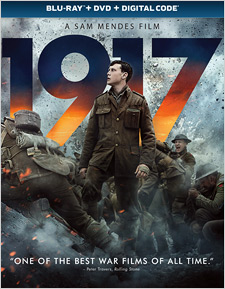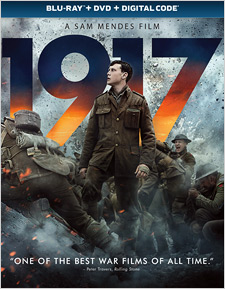1917 (Blu-ray Review)

Director
Sam MendesRelease Date(s)
2019 (March 24, 2020)Studio(s)
DreamWorks Pictures (Universal Pictures Home Entertainment)- Film/Program Grade: A
- Video Grade: A
- Audio Grade: A
- Extras Grade: C+
- Overall Grade: N/A
Review
1917 is about a World War I mission. British intelligence has discovered an imminent threat. Because the Germans have cut the telegraph wires, the British general (Colin Firth) assigns two soldiers to travel six miles through enemy territory to warn a British colonel that he and his men are heading into a trap. The lives of 1,600 men are at stake. With the attack planned for the early morning, time is crucial.
The two messengers are Lance Corporal Schofield (George McKay) and Lance Corporal Blake (Dean-Charles Chapman). Blake’s brother is among the men whose lives are in danger. The two are told that the enemy has decamped from their trenches across the wide, body-strewn no-man’s land, but there is conflicting information. Blake and Schofield don’t know what resistance they will encounter, if any.
This simple plot drives the film, with suspense building from the outset of their perilous journey. As they pass the carcasses of fly-infested horses, step over the remains of dead soldiers, make their way around flooded craters, navigate barbed wire, dodge enormous rats, and encounter booby traps, they remain resolute in their duty and push on.
Director Sam Mendes (Skyfall, Revolutionary Road) had the entire film shot in very long takes. This approach (aided by some digital intervention) gives the impression that we are seeing one continuous shot. The process required elaborate choreography of actors, extras, camera moves, and dialogue delivery. An early scene, for instance, shows Blake and Schofield resting by a low stone wall. A messenger summons Blake to the general’s tent and tells him to bring along another soldier. Thinking this will be a routine job, Blake picks his pal, Schofield. As they rise and walk past other soldiers going about their routines, Blake and Schofield conjecture what the summons might mean. Their walk takes several minutes until they reach the general’s tent and he explains the mission. In a typical film, this action might be broken into several shots—establishing shot, medium shot of the two men, close-ups of Blake, Schofield and the messenger, and maybe a tracking shot or two. By staying with the actors in the same shot while keeping them in constant motion, Mendes sets the tone for what will follow—unusually long takes as the men move forward on their journey.
Roger Deakins’ cinematography is balletic in its smoothness and precision. The camera, always in motion, tracks in front of actors and circles around them to reveal approaching landscapes and structures, often rotating nearly 360 degrees. Often, these views are green and lush, belying the fact that war is raging over the next hill. Other times, we see the men heading into areas that may hide German snipers.
1917 rests squarely on the shoulders of relative unknowns McKay and Chapman. Though their characters are young, they are already seasoned soldiers who understand their duty to the chain of command and to their country, and know full well that they might not fulfill their mission and that death is a real possibility. Schofield resents that Blake has chosen him, but this doesn’t gnaw at him. There’s too much else to worry about, and there’s a job to be done.
The script by Mendes and Krysty Wilson-Cairms doesn’t let us get to know much about Blake and Schofield, apart from the fact that Blake’s brother is among the 1,600 endangered men they are assigned to save. There are opportunities during the quieter moments of their trek, but the men speak only about strategies to achieve their goal. Both actors have charm, which should have been built upon with dialogue, giving us insight into their characters’ backgrounds. A scene intended to have emotional impact, for instance, plays as a matter-of-fact occurrence because we haven’t felt a personal connection.
The setting of World War I—the last major conflict to feature horses in warfare and the first to incorporate airplanes—is recreated, with the crowded trenches as a major visual element. As the men make their way through the maze of narrow paths, we see stagnant water pooling at the bottom of the trenches, carved out sections of dirt where soldiers cook, reclining soldiers smoking, eating, playing cards, and a constant parade of soldiers moving in both directions. Dug deep enough to clear the heads of the tallest soldiers, the trenches are rat-infested, damp, and miserable, but they are the only barrier between the men and immediate death.
War films generally deal with big issues such as causes, crucial battles, and politics. In 1917, director Mendes narrows his view to a couple of guys given the responsibility of saving the lives of a great many. With constant tension, the film follows the men as they use their training and wits to prevail.
The R-rated Blu-ray release, featuring 1080p resolution, is presented in the widescreen format of 2.39:1. Roger Deakins’ high resolution digital cinematography places the viewer right in the trenches and on the wide open fields where the two soldiers must traverse. Using extremely long takes, the film gives the impression that we’re watching the action in real time. The production design is impressive, with details inside the trenches showing how the men do their best with what they have. Textures are varied, from the gear that Schofield and Blake carry through the Hellish no-man’s land with its barbed wire, pools of muddy water, and both human and equine corpses. Facial details are sharp, with dirt and sweat clearly visible. The overall palette leans toward drab, dull colors—the browns of soldiers’ uniforms, the mud of the trenches, the deep shadows of a house in an almost deserted town, and smoke from shell explosions. A green field that the two men cross and a bunch of cherry trees with their white blossoms add some brightness. A huge fire is the primary illumination in a key scene.
The English Dolby Atmos soundtrack, with its theater-quality surround sound, puts the viewer directly in the action. Dialogue is remarkably sharp, considering how lengthy the takes are. Ambient sound is well balanced so that the dialogue dominates. As Schofield and Blake make their way over the trenches into no-man’s land, subtle sounds, such as barbed wire being pulled apart, boots sloshing through puddles of water, and the men’s footsteps, add suspense. When an exhausted Schofield is in a river, we hear the sound of raging water. Three planes involved in a dogfight can be heard as the two men watch. A loud plane crash breaks into an otherwise quiet scene. Explosions on the battlefield illustrate how close death can be. The sound of soldiers charging over trenches, yelling a battle cry to boost their courage, is mixed with shells exploding all around them. There’s also an alternate 2.0 Dolby Digital soundtrack, and French and Spanish soundtrack options. Subtitles include French, Spanish, and English (for the hearing impaired).
Bonus materials on the 2-Disc Blu-ray/DVD Combo Pack include 5 short behind-the-scenes featurettes, a director’s audio commentary, and a cinematographer’s audio commentary. A Digital Code on a paper insert is included inside the package as well.
Audio Commentary by Director Sam Mendes – Mendes is also the producer and co-writer of the film. He based the script on his grandfather’s stories about World War I. It wasn’t necessary for the audience to know the historical context. Mendes wanted to create an unlikely friendship between Schofield and Blake. The long opening shot had to show their relationship without excessive exposition as well as the trenches to create a sense of claustrophobic entrapment. Most of the men on the Western front spent their time waiting. The trenches for the film weren’t built until it was determined how long scenes would run. The Allied and German trenches differed in how they were constructed. Music heightens the suspense as Blake and Schofield look through the German trenches. Throughout the commentary, Mendes often just mentions what’s happening on screen without providing any particular insights. Other times, he discusses how elaborate sequences were planned and filmed. These explanations are fascinating.
Audio Commentary by Cinematographer Roger Deakins – Deakins goes through a technical description of the various cameras and accessories he used to make the film and details how special accommodations had to be made for specific scenes. Every scene required precise measurement to make sure dialogue would match the length of land being traversed. Filming in the trenches involved a small camera mounted on a steadicam rig to provide smooth images. In some scenes, screens mounted in an off-camera van monitored how scenes looked through the camera. In others, a monitor wasn’t available. For a number of scenes, the camera operator had to walk backwards. Extensive rehearsals were necessary. Deakins discusses the blend of CGI, blue screen, and on-location footage. Sometimes, within the same shot, the camera had to be removed from a crane to be handheld.
The Weight of the World: Sam Mendes – Director Mendes was looking for a project, but nothing interested him, so his agent suggested that he write a script of his own. Mendes remembered his grandfather telling him stories about World War I, and realized that was the story he wanted to tell. It was Mendes’ “passion project.” He wanted viewers to feel like they were in the trenches.
Allied Forces: Making 1917 – Director Sam Mendes and director of photography Roger Deakins discuss the complexity of shooting the film. Months were spent researching different camera techniques. The camera was sometimes mounted on a crane, sometimes a steadicam, and other times a gimbal. A smaller version of the steadicam, called the “dragonfly,” was developed which enabled the camera operator to move through the trenches with the actors. Major concerns included matching action, timing, and lighting while in the process of filming. The production crew took on a “pioneer mentality” in figuring how to shoot various scenes. Every scene had to be rehearsed on location and performances had to feel like second nature. Actors and mechanics had to be in sync. Several behind-the-scenes shots show scenes being rehearsed and filmed.
The Score of 1917 – Director Mendes notes that you make a film four times—when you write, when you shoot, when you edit, and when you score. Composer Thomas Newman began creating the musical score early on, working as the film was shooting rather than the usual way: scoring only after editing is completed. Scenes of the large orchestra recording, with Newman conducting, are intercut with scenes from the film. The music had to magnify the film’s rhythmical shifts.
In the Trenches – Actors Dean-Charles Chapman and George McKay were “new to the game” and not familiar to audiences. McKay had an honorable, ageless quality. He wanted to have a full sense of who his character, Schofield, was. Chapman conveyed a sweetness and innocence. The “dream cast” includes Colin Firth, Benedict Cumberbatch, Richard Madden, and Mark Strong.
Recreating History – Production designer Dennis Gassner worked with Sam Mendes previously. The challenges of prepping the film were enormous. Scenes were measured against actual land to determine how long it would take to get from point A to point B. The scene had to be the exact length of the land. “The world has to be crafted around the rhythm of the script.” The locations were just vast stretches of empty land. Models were built to guide the construction crew. A huge, mile-long trench system was dug. The farmhouse was built in a wide expanse of land. The town set had to reflect the effects of four years of war.
– Dennis Seuling

